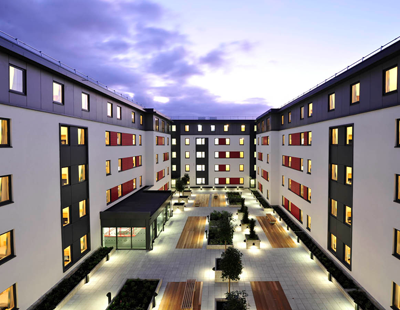Students want quality accommodation – consider your type of property carefully
The main types of student accommodation are HMOs, student pods and student apartments.
If investing in Houses of Multiple Occupancy (HMOs), bear in mind that many students will no longer settle for run down HMOs often associated with student lets.
It is worth investing in quality HMO builds to attract a higher quality tenant. If you refurbish the property so that it can only be sold on as a HMO (as opposed to landlords who convert the property with minimum investment, meaning that the property can be sold on as a one-family home), this will generate better business value but you must ensure you hold the correct license with the local council.
- Student pods are a room inside a student block that has shared facilities, including kitchens and bathrooms. If this is your choice of investment, take into account that student pods have limited re-sale potential. A more flexible option may be a student apartment, which can be sold to home-occupiers or investors.
- Student apartments are much like standard self-contained apartments, incorporating a bathroom, living room, kitchen and bathroom; however they are typically in blocks with shared services such as laundry facilities and communal areas. Self-contained student apartments also appeal to the international student market, a continuously growing sector according to figures from the Higher Education Statistics Authority.
By appealing to this market, investors will see continued demand for their properties as the trend for international students coming to the UK grows.
Both student pods and student apartments fall under the term Purpose Built Student Accommodation (PBSA). PBSA differs from usual buy-to-let properties as the accommodation has been built with students in mind. The properties usually have communal areas, high-speed wifi and are located close to university campuses. The increase in PBSA over the past 20 years has been essential to the UK higher education sector’s growth both domestically and internationally.
The importance of location
Students are prepared to pay a premium for accommodation in Russell Group university cities. According to the Accommodation for Students’ annual report, students attending five of the UK’s top universities are prepared to pay an additional £20-£58 per week in rent above the national average for accommodation in order to study at these institutions.
This highlights the importance of choosing the right area for the best return on investment; student accommodation needs to be close to universities. Towns with multiple universities also tend to attract more students; for the simple reason that there are multiple institutions all taking people in.
It is also advisable to look at the local amenities. Locations with shops, bars, cafés and grocery stores nearby are popular amongst students, as many do not have their own vehicles, in addition near a train station for those that commute home regularly
Catering to student preferences
Many students prefer to have the cost of utilities included in advertised rates, so they can manage their costs of living better.
Most PBSA properties also offer amenities such as high-speed internet, 24-hour resident security and communal areas to attract students.
In certain locations, demand far overtakes supply, increasing investor yields
Increasing demand from students for PBSA from students and low stock levels means that there are significant undersupplies of PBSA across the UK. For example, in Glasgow only around 10% of students in the Scottish city can access the PBSA, while almost 70% of students in the historic city of York aren’t able to secure this type of property.
The result is that current PBSAs carry rental premiums that students are prepared to pay. In Glasgow, for example, students will pay as much as 30% more than average rental rates to secure a room in one of the city’s PBSA developments.
This has increased rental rates in the sector and, consequently, helped to drive yields for investors.
Research your finance options
Because investing in PBSA is seen as a business venture, mainstream mortgage lenders do not lend against this type of rental property. It is advisable to use a broker to source the best form of finance for you from more specialist lenders.
If you’re investing through a developer, conduct a lot of research into the firm you are investing in. Look into the company’s history, how long they have been going, what their experience in the market is, and how many properties they have sold in the past.
Student property is a particularly popular asset class, and this is unsurprising considering the high returns on investment. However, as with any investment, your property needs to fit your business model and fulfil your financial needs, so do your research properly.
Careful research could mean you benefit from high returns for years to come but you must budget for the term periods that on average equate to 9 months of the year, so you need to ensure the rents cover the 12 month costs i.e mortgage payments and so on.
*This article was written by Karl Griggs, Director at Commercial Processing Centre








.png)

.jpg)








Join the conversation
Be the first to comment (please use the comment box below)
Please login to comment